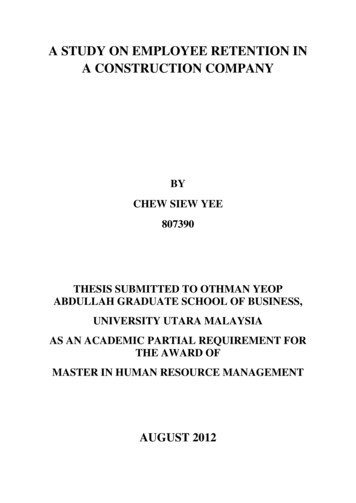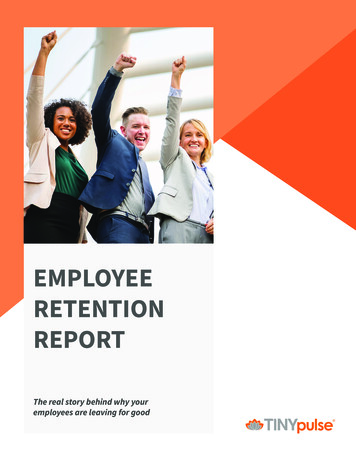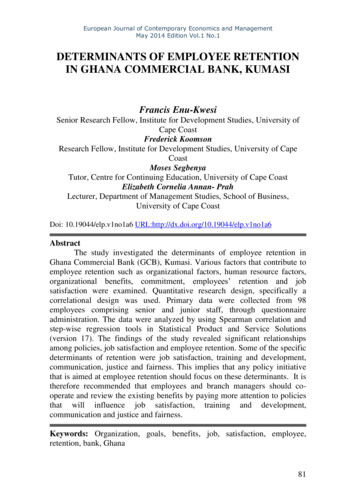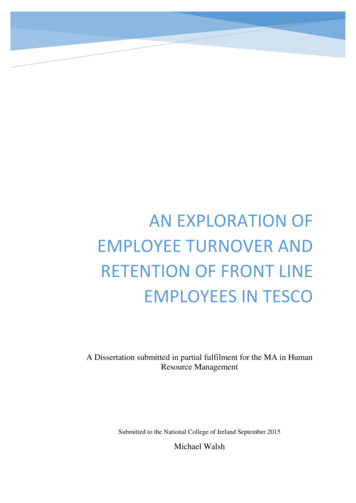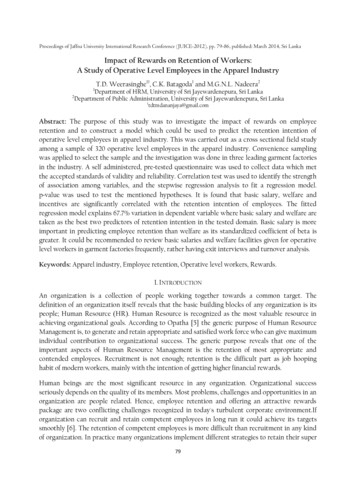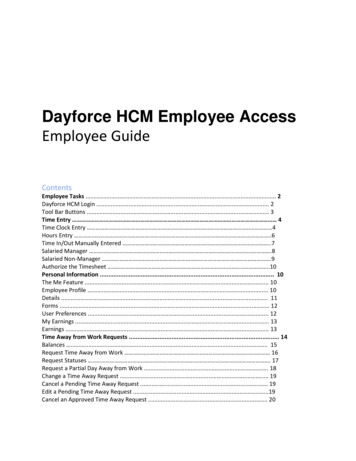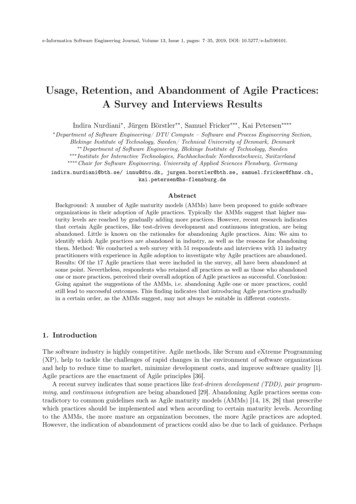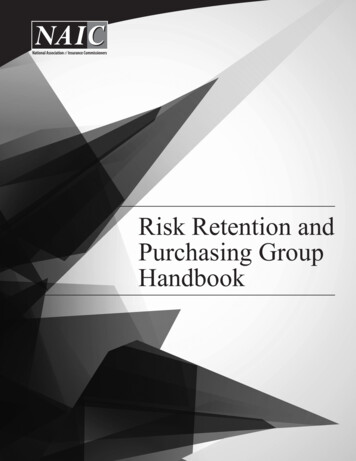
Transcription
International Journal of Pure and Applied MathematicsVolume 119 No. 12 2018, 1523-1543ISSN: 1314-3395 (on-line version)url: http://www.ijpam.euSpecial Issueijpam.euA STUDY ON EMPLOYEE RETENTION WITH SPECIALREFERENCE AT PHILIPS ELECTRONICS, CHENNAIJ.Pavithra1, Thirukumaran2Assistant Professor1, Student2, Department of Management Studies1,2BIST, BIHER, Bharath University, Chennaipavithra.mba@bharathuniv.ac.inABSTRACTThe research titled on “A Study on employee retention strategies with special reference toPHILIPS ELECTRONICS INDIA LIMITED” Chennai was conducted.Employee retention is the systematic effort to retain the current employees by providing bestpolicies and to recognize various expectations of the employees. The challenge is not only toattract the talented employees and to retain them.The objective of the study is to analyze the organizational factors influencing the employeeretention and to find individual factors leading employees to leave the organization and toexamine the necessary conditions to retain the employees.The study has done through descriptive research method and the collection of primary data hasdone through single cluster sampling method under probability sampling method. The researchdesign followed in this study is descriptive research.Questionnaire is used to collect primary data and conceptual review is used for secondary datacollection through books, websites.The data is to be analyzed with percentage analysis, chi square & one sample run test andinterpretation will be followed.From the study, the findings shows that the respondents are not satisfied with compensationbenefits & working environment, the employees feel that their work load is high.The company can implement better working environment to the employees; they can provideproper job rotation to motivate them. Provide flexible work schedule to the employees.INTRODUCTIONEffective employee retention is a systematic effort by employers to create and foster anenvironment that encourages current employees to remain employed by having policies andpractices in place that address their diverse needs[1-6].1523
International Journal of Pure and Applied MathematicsSpecial IssueRetention of key employees is critical to the long term health and success of any organization.It is a known fact that retaining your best employees ensures customer satisfaction, increasedproduct sales, satisfied colleagues and reporting staff, effective succession planning and deeplyimbedded organizational knowledge and learning[7-10].Employee retention matters as organizational issues such as training time and investment, lostknowledge, insecure employees and a costly proposition for an organization.Various estimates suggest losing a middle manager in most organizations costs up to five timesof his salary.CONCEPT OF EMPLOYEE RETENTION:Whenever the economy picks up, it will have positive impact on the jobmarket resulting in more employment options.This would lead to high turnover rates. As more and more organizations pass through rapidlychanging complex business environment, their employees feel uncertain about the future. Therules of the game keep changing.The expectations of the management goals and priorities change very often. This would putheavy pressure on the employees which leads to increased stress, demoralization, andabsenteeism, decreased productivity, this all will affect the rate of employee retention.Since people are the most valuable assets, losing them costs money to the organization.Surprisingly, many companies do not make any effort to reduce employee turnover or find outwhy employees leave and most of them do not rely on any resources to why employee leave.Companies increasingly finding it difficult o retain talents. Attracting the best talent is one partwhere as retaining them is another challenge[11-14].Employee retention is simple to understand, but at the same time it can be difficult to achieve.Knowing what employees want and need is a step in the right direction. Managers mustacknowledge and accept that they are accountable for managing the factors within their controlto help to retain their most valued employees.Intelligent employees always realize the importance of retaining the best talent. Retaining talenthas been so important in the Indian scenario.1524
International Journal of Pure and Applied MathematicsSpecial IssueHowever, a thing is no dearth of opportunities for the best in the business, or even for the secondor the third best. Retention of key employees and treating attrition troubles has never been soimportant to companies.In an intensely competitive environment, where HR managers are poaching from each other,organizations can either hold on to their employees tight or lose them to competition. For goneare the days, when employees would stick to an employer fir years for want of a better choice.Now, opportunities abound.It is a fact that, retention of key employees is critical to the long term health and success of anyorganization.The performance of employees is often linked directly to quality work, customer satisfaction,and increased product sales and even to the image of a company.Whereas the same is often indirectly linked to, satisfied colleagues and reporting staff, effectivesuccession planning and deeply embedded organizational knowledge and learning.Employee retention matters as organizational issues such as training time and investment, costlycandidate search etc., are involved. Hence, failing to retain a key employee is a costlyproposition for any organization[15-19].1.2 NEED OF THE STUDY This study focus on employee retention strategies as a predictor of company performancerather than technology and also the extent to which people value, enjoy and believe inwhat they do. This study also focus on employee turnover and causes for the same. It also examines the future growth and employee value proposition.1.3 SCOPE OF THE STUDY The study is to determine the factors influencing retention of employees in theorganization. These researches also determine the nature of retaining employees in order to makethe employees to feel comfort. To motivate the employees to continue to work in the same organization with fullinterest and hence provide the results to the company it wanted.1.4 OBJECTIVE OF THE STUDY1525
International Journal of Pure and Applied MathematicsSpecial IssuePRIMARY OBJECTIVE To study the employee retention strategies with reference to PHILIPS ELECTRONICSINDIA Ltd, Chennai.SECONDARY OBJECTIVE To study the organizational factors influencing retention strategies To find the individual factors leading employees to leave the organization. To examine the necessary conditions to retain the employees1.5 LIMITATIONS OF THE STUDY The study was carried out only certain number of employees. The employees were not ready to answer for few questions. At times certain employees were not accurate in their responses. Time is the major constraint. Given forty five days time is not sufficient to go in depth ofthe study.1.5 RESEARCH METHODOLOGYResearch methodology is a way to systematically solve the research problem. Itmay beunderstood as a science of studying how research is done scientifically and the methods adoptedin a research study. Methodology adopted in this period of work is descriptive type.TYPES OF RESEAREHThe basic types of research are as follows:DESCRIPTIVE Vs. ANALYTICAL:Descriptive research includes surveys and fact- finding enquiries of different kinds. The majorpurpose of descriptive research is description of the state of affairs as it at present. In socialsciences and business research we quite often use the term Ex post facto research for descriptiveresearch studies. The main characteristic of this method is that the researcher has no control overthe variables; he can only report what has happened or what is happening. Most Ex post factoresearch projects are used for descriptive studies in which the researcher seeks to measure suchas, for example, frequency of shopping[20-24].APPLIED Vs. FUNDAMENTAL RESEARCH:Research can either be applied (or action) research or fundamental (to basic or pure) research.Applied research aims at finding a solution for an immediate problem facing a society or an1526
International Journal of Pure and Applied MathematicsSpecial Issueindustrial/business organization, whereas fundamental research is mainly concerned withgeneralizations and with the formulation of a theory. “Gathering knowledge for knowledge‟ssake is termed „pure‟ or „basic‟ research[25-31].QUANTITATIVE Vs. QUALITATIVE:Quantitative research is based on the measurement of quantity or amount. It is applicable tophenomena that can be expressed in terms of quantity. Qualitative research, on the other hand, isconcerned with qualitative phenomena, i.e., phenomena relating to or involving quality or kind.For instance, when we are interested in investigating the reasons for human think or do certainthings), we quite often talk of „Motivation Research‟, an important type of qualitative research.CONCEPTUAL Vs. EMPIRICAL:Conceptual research is that related to some abstract idea(s) or theory. It is generally usedphilosophers and thinkers to develop new concepts or to reinterpret existing ones. On the otherhand, empirical research relies on experience or coming up with conclusions which are capableof being verified by observation or experiment.1.5.1 RESEARCH DESIGNA research design is a matter plan specifying the methods and procedures for collecting andanalyzing the needed data. It is the frame work for the research plan of action. Research designbased on the descriptive research technique employing the survey method and analysis is madeon this primary data collected for this projects study[32-36].DESCRIPTIVE RESEARCH DESIGNDescriptive research design was selected to achieve the stated objectives. Research studies arethose, which are concerned with describing the characteristics of a particular individual, or groupon determining the relationship between the variables as to be measured descriptive researchdesign was selected.The objective of the descriptive design is to answer the “who”, “what”,and “how” of the subject under investigation. Descriptive research is well structured. Primarydata is chosen for data analysis and there is no secondary data taken research analysSOURCES OF DATAThere are two types of data collected.PRIMARY DATA1527
International Journal of Pure and Applied MathematicsSpecial IssueThe primary data are those, which are collected fresh for the first time andthus happen to be original in character. We collect primary data during the course of doingexperiments in an experimental research. In our research, data was collected through thequestionnaire method[37-41].SECONDARY DATASecondary data are those are already been collected by someone else. Thesecondary data are collected by analyzing various materials like company profiles, magazines,journals, past records, reports and websites.POPULATION SIZEThe overall population size taken in the project is 250.SAMPLING UNITManagement staff (MS).SAMPLING SIZEThe overall sample size taken in the project is 150 respondents of employees.SAMPLING INSTRUMENTA questionnaire is a schedule consisting of a number of coherent and formulatedseries of question related to the various aspects of the under study. In this method a pre – printedlist of question arranged in sequence is used to elicit response from the important.The questionnaire has been framed by covering almost the key concept to bring about lucidresults. The questionnaire includes multiple choices, dichotomous question and open endedquestion1.5.4 SAMPLINGSAMPLING METHODHere the cluster sampling method is used to collect the data-usingquestionnaire.CLUSTER SAMPLINGIf the total area of interest happens to be a big one, a convenient way in whicha sample can be taken is to divide the area into number of smaller non – overlapping areas andthen randomly select a number of these smaller areas (usually called clusters), with the ultimate1528
International Journal of Pure and Applied MathematicsSpecial Issuesample consisting of all (or samples of) units in these small areas or clusters. Cluster samplingsare usually more reliable per unit cost.1.5.6 ANALYSIS TOOLS percentage analysis method chi-square test one sample run test1. PERCENTAGE ANALYSIS METHOD:Percentage method is the most common method used. It helps the researcher to make acomparison with two or series of data and also to describe. This relationship is comparativerelative terms.FORMULA:Percentage of respondents (number of respondents/total respondents* 100)2. CHI SQUARE TEST:The chi-square test is an important test among the several tests ofsignificance developed by statisticians. The chi-square is a statistical measure used in the contextof sampling analysis for comparing the variance to a theoretical value. As a non-parametric test,it can be used to determine whether categorical data shows dependency or the two classificationsare independent[42-45].FORMULA:CHI SQUARE Σ (Oi – Ei) 2/ EiOi Observed frequencyEi Expected frequency3. THE ONE SAMPLE RUN TESTIt is a non-parametric method to determine the randomness with which the sampling itemshave been selected. The run test, based on the order in which the sample observation is obtained,in a useful technique for testing the null-hypothesis Ho that the observations have indeed beendrawn at random.A run is defined as a set of identical (or related) symbols contained between two differentsamples or no symbol.FORMULA:1529
International Journal of Pure and Applied MathematicsSpecial Issueμv 2n1 n2 1n1 n22σ v 2n1 n2 (2n1n2-n1-n2)(n1 n2)2 (n1 n2-1)Z V-μvσvWhere,v number of runsμv mean of v-statisticn1 the number of first responsen2 the number of second responseσ2v variance of v- statisticσv the standard error (S.E) of the v- statisticTESTS OF SIGNIFICANCE HYPOTHESIS: a hypo
Employee retention matters as organizational issues such as training time and investment, costly candidate search etc., are involved. Hence, failing to retain a key employee is a costly proposition for any organization [15 -19] . 1.2 NEED OF THE STUDY ¾ This study focus on employee retention strategies as a predictor of company performance rather than technology and also the extent to which .
